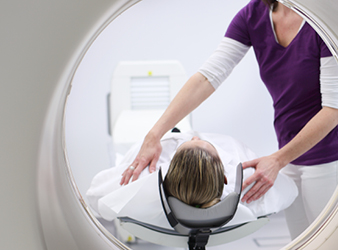PET (positron emission tomography) does not differ in principle from the other nuclear medicine procedures (scintigraphy, SPECT). Here, too, the patient receives a radioactive substance (radiopharmaceutical) and is examined with the PET scanner after a certain enrichment phase. The special feature of PET results from the decay type of the radioisotopes used, the so-called “positron emitters”: These have particularly favourable physical properties for measurement and imaging, which is why they achieve a higher spatial resolution compared to the other nuclear medicine procedures, which means that even very small lesions in the organism can be detected.
The most commonly used PET radiopharmaceutical is FDG (18FluorDesoxyGlucose). FDG is used to examine glucose metabolism, which can be increased in tumour diseases or inflammations, for example. In FDG-PET examinations of the brain, areas with a reduced glucose metabolism are of particular interest, e.g. in the context of epilepsy and dementia diagnostics.
Apart from this, there are other radiopharmaceuticals that can be used to detect and image very specific targets in the body. Due to the necessary special delivery and short life of the PET radiopharmaceuticals used, it is important to make an appointment in time and to keep the appointment on time.
These examinations are performed by the Ordination for Nuclear Medicine, Prof. Martha Hoffmann. These examinations are to be paid for privately and can be submitted to a supplementary insurance/private insurance.

Coming soon
